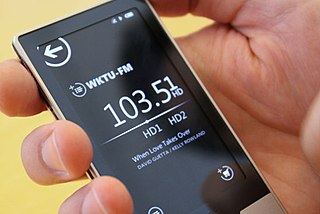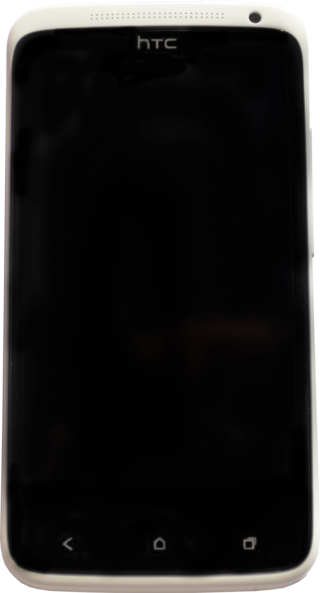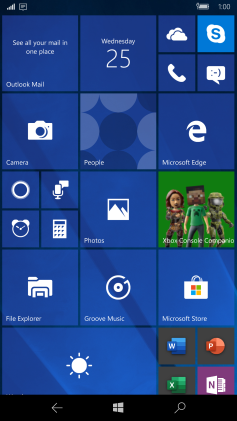
The Zune HD is a portable media player in the Zune product family released on September 15, 2009, by Microsoft. It was a direct competitor with Apple's iPod Touch series of mobile devices. It was initially released in 16 and 32 GB capacities. A 64 GB version was released on April 9, 2010. It has a touchscreen interface for navigation and included Wi-Fi for synchronization, access to the Zune Marketplace and Web browsing.

The Asus Eee Pad Transformer TF101 is a 2-in-1 detachable tablet developed by Asus that runs the Android operating system. It is the first tablet in the Asus Transformer Pad series. The Eee Pad Transformer features a 10.1-inch (260 mm) display, an Nvidia Tegra 2 dual-core chip, 1 GB of RAM, and 16 or 32 GB of storage. The tablet initially launched with Android 3.1, nicknamed "Honeycomb", but was updated to support Android 4.0.3.

A 2-in-1 laptop, also known as 2-in-1 PC, 2-in-1 tablet, laplet, tabtop, laptop tablet, or simply 2-in-1, is a portable computer that has features of both tablets and laptops.

Lenovo Yoga is a line of consumer-oriented laptop computers, tablets, and all-in-one computers designed, developed and marketed by Lenovo, named for their ability to assume multiple form factors due to a hinged screen. The line currently competes against other 2-in-1 PCs such as the HP Spectre.

The HTC One X is a touchscreen-based, slate-sized smartphone designed and manufactured by HTC. It was released running Android 4.0.3, with the HTC Sense 4.0 skin. The One X is powered by the NVIDIA Tegra 3 for most international GSM carriers, making this the first HTC phone to be equipped with a quad-core processor, while a variant which is LTE capable is powered by the Qualcomm Snapdragon S4 dual-core 1.5 GHz Krait processor. The One X was announced on February 26, 2012, at the Mobile World Congress and was HTC's sixth flagship product, leading the HTC One series from the time of its release through April 2013, when its successor the HTC One (M7) was announced.

The iPad is a tablet computer developed and marketed by Apple Inc. It is the third device in the iPad line of tablets. It added a Retina Display, the new Apple A5X chip with a quad-core graphics processor, a 5-megapixel camera, HD 1080p video recording, voice dictation, and support for LTE networks in North America. It shipped with iOS 5, which provides a platform for audio-visual media, including electronic books, periodicals, films, music, computer games, presentations and web browsing.

Microsoft Lumia is a discontinued line of mobile devices that was originally designed and marketed by Nokia and later by Microsoft Mobile. Introduced in November 2011, the line was the result of a long-term partnership between Nokia and Microsoft—as such, Lumia smartphones run on Microsoft software, the Windows Phone operating system; and later the newer Windows 10 Mobile. The Lumia name is derived from the partitive plural form of the Finnish word lumi, meaning "snow".

Windows RT is a mobile operating system developed by Microsoft and released alongside Windows 8 on October 26, 2012. It is a version of Windows 8 or Windows 8.1 built for the 32-bit ARM architecture (ARMv7), designed to take advantage of the architecture's power efficiency to allow for longer battery life, to use system-on-chip (SoC) designs to allow for thinner devices and to provide a "reliable" experience over time. Unlike Windows 8, Windows RT was only available as preloaded software on devices specifically designed for the operating system by original equipment manufacturers (OEMs); Microsoft launched its own hardware running it, the Surface tablet, which was followed by Surface 2, although only five models running Windows RT were released by third-party OEMs throughout its lifetime.

Microsoft Surface is a family of touchscreen-based personal computer, tablet, and interactive whiteboard hardware products designed and developed by Microsoft. The majority of them run the Windows operating system and use Intel processors.

VivoTab is a series of Microsoft Windows hybrid tablet computers designed by Asus. It is a sub-series of the Vivo series by Asus. The name is derived from the Latin word "to live" and, along with Asus's Transformer series of convertible devices running Windows, is a primary competitor to the Microsoft Surface.

Windows 8.1 is a release of the Windows NT operating system developed by Microsoft. It was released to manufacturing on August 27, 2013, and broadly released for retail sale on October 17, 2013, about a year after the retail release of its predecessor, and succeeded by Windows 10 on July 29, 2015. Windows 8.1 was made available for download via MSDN and Technet and available as a free upgrade for retail copies of Windows 8 and Windows RT users via the Windows Store. A server version, Windows Server 2012 R2, was released on October 18, 2013.

The Surface Pro 2 is a Surface-series 2-in-1 detachable produced by Microsoft. Unveiled at an event in New York City on September 23, 2013 and released on October 22, 2013, it succeeds the Surface Pro released in February 2013. While maintaining a design similar to the original design of its predecessor, the Surface Pro 2 has improved hardware specifications compared to it, such as a Haswell Intel Core processor and an increased number of storage options, improved versions of the kickstand and cover accessories.

The Nokia Lumia 2520 is a Windows RT tablet computer originally developed by Nokia. It is Nokia's first and only Windows-based tablet, and the company's first tablet since its Nokia Internet Tablet line. Sharing its design and marketed with the Nokia Lumia series of Windows Phone products, the device incorporates a quad-core Snapdragon 800 chip with 4G LTE support, along with a 10.1-inch (26 cm) 1080p display and an optional "Power Keyboard" dock adding additional battery capacity, USB ports, and a physical hardware keyboard. Following a period of speculation and leaks, the Lumia 2520 was officially unveiled on 22 October 2013, and released in North America on 21 November 2013.

The Nokia Lumia 1520 was a flagship Windows Phone phablet smartphone designed and produced by Finnish telecommunications manufacturer Nokia in partnership with American software manufacturer Microsoft. The device was first announced at the Nokia World event on 22 October 2013 in Abu Dhabi, alongside its mid-range phablet stablemate the Nokia Lumia 1320 and Nokia's 10.1 inch Windows RT tablet the Nokia Lumia 2520. Until its discontinuation in the United States on 7 April 2015 the phone served as the flagship device for Nokia's Lumia Series and Microsoft's mobile effort. On 6 October 2015 Microsoft officially announced its flagship phablet successor, the Microsoft Lumia 950 XL, with availability sometime in November 2015.
Surface Mini is an unreleased tablet computer that Microsoft designed as the successor to the Surface 2 in the Microsoft Surface family. The device has a Qualcomm Snapdragon 800 processor and a 7.5-inch (19 cm) 4:3 aspect ratio touchscreen display that defaults to portrait mode. Like its predecessor, the Surface Mini runs Windows RT 8.1, a mobile operating system that was designed for the ARM architecture and has limitations including an inability to install Win32 applications; programs can only be installed from the Windows Store.

The first-generation Surface is a hybrid tablet computer developed and manufactured by Microsoft. Announced in June 2012, it was released in October 2012, and was the first personal computer designed in-house by Microsoft.

Surface 3 is a 2-in-1 detachable from the Microsoft Surface series, introduced by Microsoft in 2015. Unlike its predecessor, the Surface 2, Surface 3 utilizes an x86 Intel Atom system-on-chip architecture, or SoC, rather than a processor with ARM architecture such as the Nvidia Tegra that powered the Surface 2, and runs standard versions of Windows 8.1 or Windows 10.

Windows 10 Mobile is a discontinued mobile operating system developed by Microsoft Mobile. First released in 2015, it is the successor to Windows Phone 8.1, but was marketed by Microsoft as being an edition of its PC operating system Windows 10.

The Surface Pro X is a 2-in-1 detachable tablet computer developed by Microsoft. It was developed alongside and was announced on 2 October 2019 alongside the Surface Pro 7 and Surface Laptop 3. Updated hardware was announced alongside Surface Laptop Go and Surface accessories on October 1, 2020 and September 22, 2021. The device starts at $899.99 USD / £849.99.





















